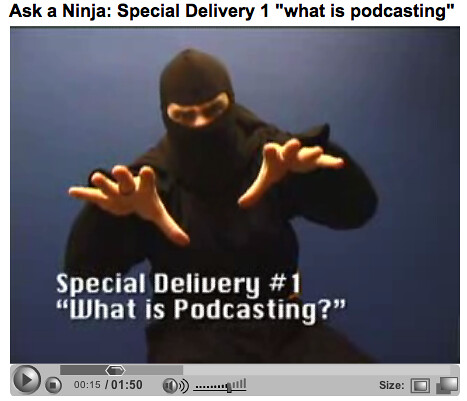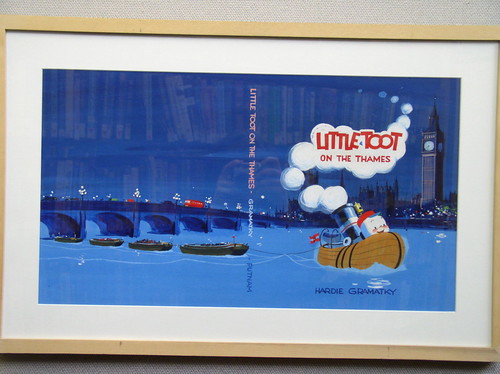Monday, February 4, 2008
Thing 30: Finished
How could things have been better? Some of the links that did not work on all computers could have been tested more thoroughly before being published--however, broken links are just part of doing business on the Internet. Maybe in the future the planners could designate someone at each agency to act as a guide through the process, so that if someone has a problem, there is an actual person they can talk to about it. Might need at least two guides at a place like PA with multiple shifts. : )
Would I sign up for another "discovery" program like this? it would depend on the content. If it was work related and looked fun and promised the camradarie this one provided, yes.
Sunday, January 27, 2008
Thing 29: About My Learning 2.0 Experience
My favorite "Things" were the visual ones--I loved searching for pictures in Flckr and turning photos into magazine covers, movie posters, trading cards, and hazardous warning labels--all of which I tried. I can see myself using these tools to create flyers or props for library programs.
My favorite part of Learning 2.0 was the way it pulled together the staff. We were learning and playing together, sharing images we found on Flckr, podcasts, mash-ups, YouTube videos and more. It helped so much when I was frustrated with an assignment to have co-workers commiserate or offer suggestions. I really appreciate the experience, knowledge, and patience of the Princess Anne staff.
Thing 28: Rolly-O
I searched Rolly-O for an existing search roll on the subject of children's books. I found it annoying that so many of the hits were still booksellers; I was hoping to find reviews, lesson plans, storytime ideas. Next, I tried the term "full text"and found that most of the children's books were too old to be relevant. Then I tried searching Rolly-O for search rolls based on fingerplays. Bingo. I found some really nice search tools for storytime resources. This was something useful!
Sunday, January 6, 2008
Thing 27: Take a look at Library Thing

Thing 26: Online Image generators

I played with some of the toys on the Generator Blog. The Warholize it generator, was my favorite. I found that images with a strong black and white and component came out clearest--this panda photo my father in law took at the Memphis Zoo was my favorite. I want post cards made from it. I wonder if I could use this software to make banners/signage for displays? Or at least to create images to brighten my flyers up?
I also played with creating a countdown for Summer Reading Program on two of the ticker generators, and selected a buggy one from the The Ticker Factory to add as an element to my blog.
Some of the items on the Generator blog were crude and disgusting--I stumbled on a booger generator--and there were others that were blocked outright by WebSense. Some of the links were broken.
Thursday, January 3, 2008
Thing 25: Podcasting, Video & the Library
Once again, this assignment was made harder by the Library's filtering software. I explored how podcasts were used at Denver Public Library and Arizona State University. I loved the way Denver used the podcasting to share audio stories for children. Arizona State, not surprisingly, focused more on reference than reader's advisory. They provided guides to library resources, highlighted databases, and explained how to cite resources. Unfortunately, I was unable to play any of the podcasts, even when I used the public access Internet terminals and loaded the podcasts into my RSS Feeder. The only public access Internet stations with sound at my branch are also the most heavily filtered. I was very disappointed.
I really admired how Denver's catalog integrated the Internet and library resources. Searching in the catalog, a customer can directly download and audio book, create a NetLibrary account, or request an ILL. I wish Va. Beach had such a smooth interface! Our customers have to move from the catalog to one of the Internet PCs and leave the catalog altogether to ILL. I especially liked the "Didn't Find It?" feature.
Wednesday, January 2, 2008
Thing 24: Explore Podcasting
This has been an exercise in frustration. My first searches on Yahoo pulled up music podcasts that required money to download. I decided to search NPR, figuring that would be free--and discovered that ComIT had blocked streaming content. So...I tracked down a staff member who had successfully uploaded an NPR podcast to her RSS feed. She walked me through the steps. This was not an "intuitive" process.
However, I was really pleased with the offerings on NPR. I listened to Daniel Pinkwater reading from a reissue of "Little Toot". I looked at some other book review sites, alas not many were for children's books. I think I will check out the movie reviews next. This could really help me with Reader's Advisory. I could listen to podcasts while doing circulation tasks in the back.

